
| Component | Description | Manufacturing Process |
|---|---|---|
| Enclosure | The outer shell of the kiosk, protecting internal components. | Fabricated from metal or durable plastic; includes assembly of structural components. |
| Touchscreen Display | Allows users to interact with the ATM interface. | Assembled with touch-sensitive technology; integrated with the main control unit. |
| Card Reader | Reads and processes ATM cards for transactions. | Installed and calibrated; integrated with security modules for encryption. |
| Cash Dispenser | Dispenses cash to users after transactions. | Assembled with a secure cash-handling mechanism; tested for accuracy and reliability. |
| Deposit Module | Accepts cash and checks for deposits. | Includes components for document and currency validation; tested for accuracy. |
| Receipt Printer | Prints transaction receipts for users. | Assembled with high-quality print mechanisms; tested for reliability and clarity. |
| Security Camera | Monitors and records activity around the ATM. | Installed with appropriate wiring and integration with security systems. |
| Control Unit | Central processing unit that manages all kiosk operations. | Assembled with integrated circuits and software; tested for functional integrity. |
| Power Supply | Provides electrical power to the ATM. | Installed with safety measures and tested for consistent power delivery. |
| Communication Module | Handles data transmission between the ATM and banking networks. | Integrated and tested for connectivity and data security. |
ATM kiosk integrates both hardware and software to deliver a seamless banking experience. The hardware includes a sturdy enclosure that houses the touchscreen display, card reader, cash dispenser, deposit module, receipt printer, and security camera. The control unit manages the hardware interactions and processes transactions, while the power supply ensures consistent operation. The software component includes the operating system and application software that drive the user interface, manage transactions, and handle communications with banking networks. Advanced security features, such as encryption and fraud detection software, are critical for protecting user data and preventing unauthorized access. Together, the hardware and software ensure that ATM kiosks function reliably, securely, and efficiently, providing users with convenient access to banking services.
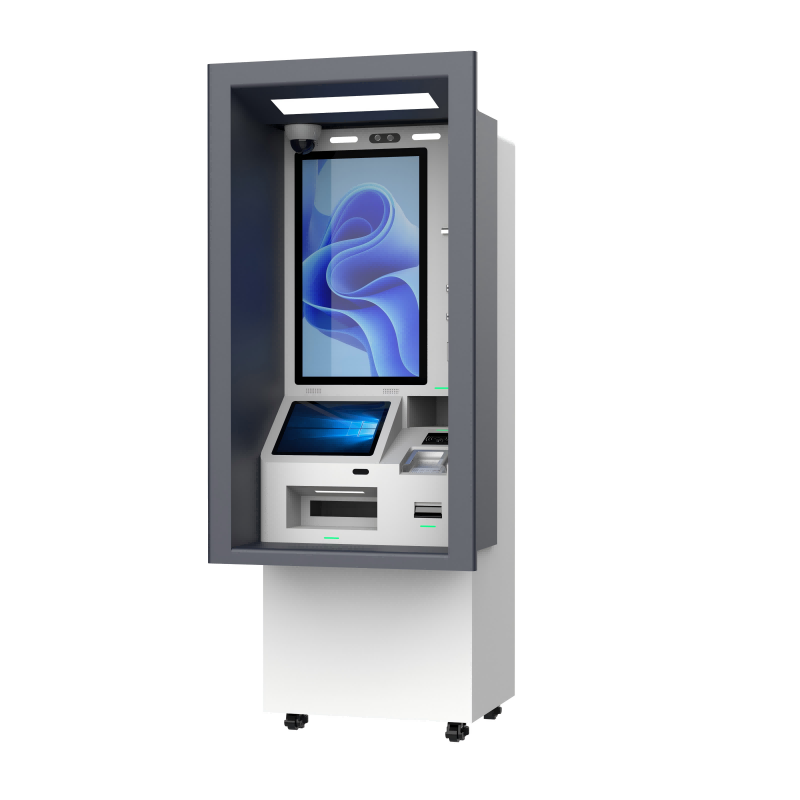
User Authentication: The user inserts their ATM card into the card reader. The card is read and authenticated by the system, which communicates with the bank’s server to verify the card details and user credentials.
Transaction Selection: The user selects the type of transaction they wish to perform from the touchscreen menu, such as cash withdrawal, balance inquiry, or deposit.
Input and Verification: The user enters necessary details, such as the amount of cash to withdraw or deposit, and enters their PIN for security verification. The system processes this information and communicates with the bank’s server to authorize the transaction.
Cash Handling: For cash withdrawals, the ATM’s cash dispenser retrieves the requested amount from its secure cash vault and dispenses it to the user. For deposits, the machine validates the cash or checks and deposits them into the user's account.
Receipt Printing: After completing the transaction, the ATM prints a receipt if requested. The receipt includes transaction details for the user’s records.
Card Ejection and Exit: The ATM ejects the card and completes the transaction. The user takes their card and any cash or receipt, and the system resets for the next transaction.
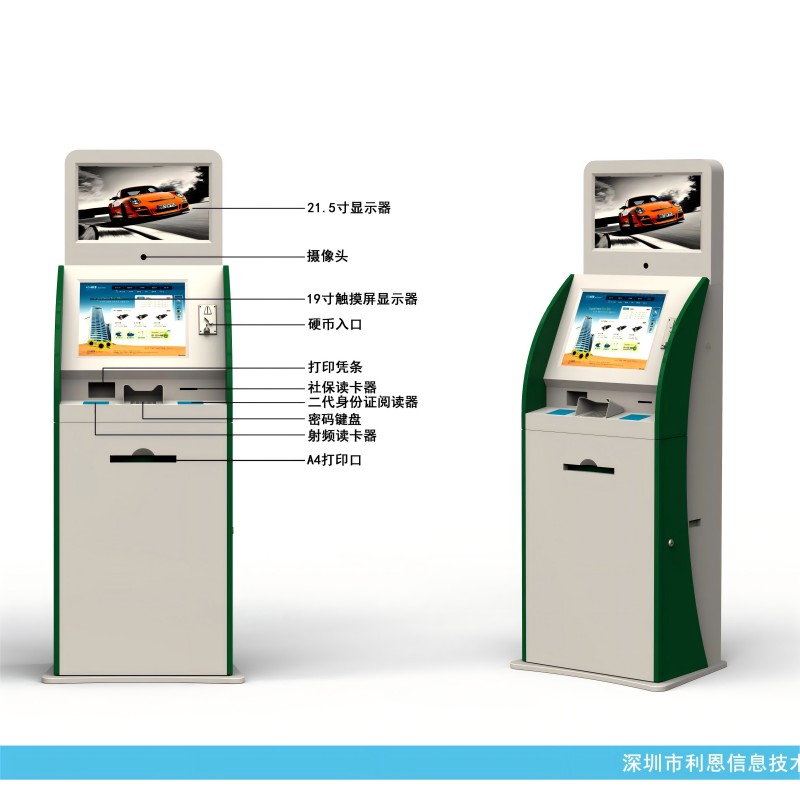
Insert Card: Insert your ATM or debit card into the card reader slot. Ensure it’s inserted correctly and fully to be read by the machine.
Enter PIN: Follow the on-screen prompts to enter your Personal Identification Number (PIN) using the touchscreen or keypad. This step verifies your identity.
Select Transaction Type: Choose the type of transaction you wish to perform from the menu options, such as cash withdrawal, balance inquiry, or deposit.
Input Transaction Details: For cash withdrawals, enter the amount you wish to withdraw. For deposits, follow the instructions to insert cash or checks. Ensure all amounts and details are correct.
Confirm and Process: Review and confirm the transaction details on the screen. The ATM will process your request and communicate with your bank to complete the transaction.
Collect Cash and Receipt: Once the transaction is approved, the ATM will dispense cash if requested and print a receipt if you opted for one. Take your card, cash, and receipt before leaving.
Complete Transaction: Ensure you have collected all items and confirm the transaction is complete. The ATM will reset and be ready for the next user.

24/7 Banking Access: Use an ATM kiosk when you need to perform banking transactions outside of regular banking hours or on weekends, as many ATMs are available 24/7.
Cash Withdrawals: When you need to access cash quickly, an ATM kiosk allows you to withdraw money from your account without needing to visit a bank branch.
Account Balance Inquiries: Check your account balance at an ATM kiosk to keep track of your finances without having to log into your online banking account.
Deposit Funds: Use an ATM kiosk to deposit cash or checks into your account, which can be more convenient than visiting a bank branch during business hours.
Transfer Funds: Perform internal transfers between your accounts or to other accounts, making it easy to manage your finances and move money as needed.
Printing Statements: Obtain mini statements or transaction receipts from an ATM kiosk to review recent account activity or for record-keeping purposes.

Customization options for ATM kiosks are extensive, allowing businesses and financial institutions to tailor these machines to meet specific needs. One of the primary customization options is branding, where the exterior design, colors, and logos can be customized to reflect the brand identity of the bank or institution. Screen interface customization is also crucial, enabling institutions to design user-friendly and intuitive interfaces that enhance the customer experience. Additionally, hardware configurations can be adjusted, such as adding biometric scanners for enhanced security or upgrading card readers to support contactless payments. Software integration is another key area, allowing the kiosk to be connected with various banking systems, CRM tools, and third-party applications to offer services like mobile banking or account management. Accessibility features can also be customized, including the installation of braille keypads, voice-guided instructions, and adjustable screen heights to accommodate all users. Lastly, service offerings within the kiosk can be tailored, such as enabling bill payments, loan applications, or even currency exchange, making the ATM a versatile tool for customers. These customization options help create a unique and efficient solution that aligns with the institution's goals and customer expectations.
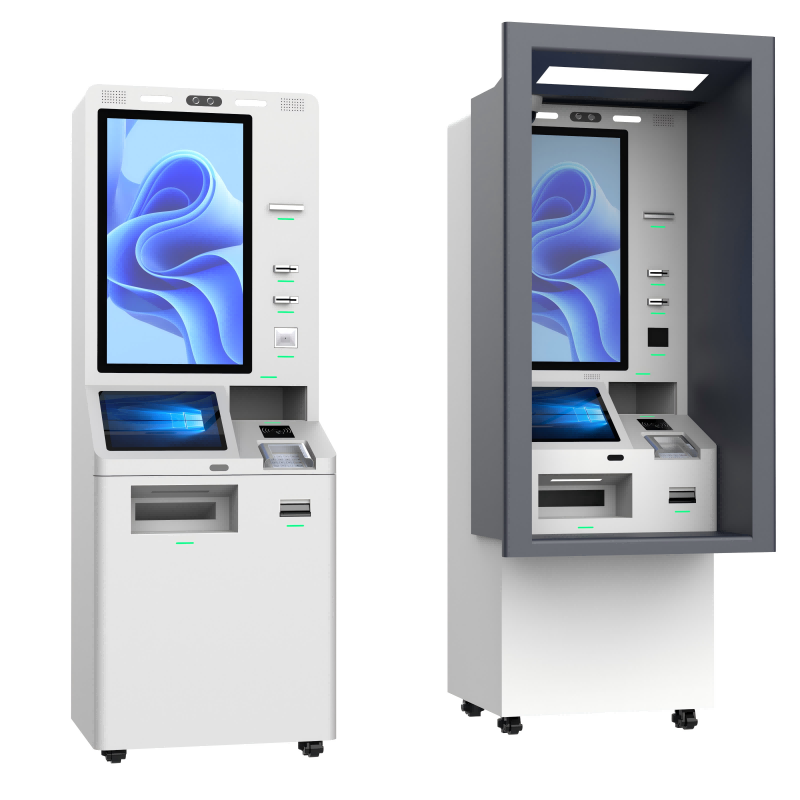
Enhanced Accessibility: ATM kiosks provide 24/7 access to banking services, enabling customers to perform transactions at any time, which is especially beneficial in areas with limited branch hours.
Increased Efficiency: These kiosks reduce wait times by handling routine transactions like cash withdrawals, deposits, and balance inquiries, freeing up bank staff to focus on more complex customer needs.
Cost Savings: By automating routine banking tasks, ATM kiosks help financial institutions reduce operational costs, minimizing the need for additional tellers and branch expansions.
Improved Customer Experience: ATM kiosks offer a user-friendly interface and a wide range of services, providing a convenient and fast way for customers to manage their finances without needing to enter a branch.
Security Features: Modern ATM kiosks come equipped with advanced security features, such as biometric authentication and encryption, ensuring safe transactions and protecting customer data.
Wider Reach: ATM kiosks can be installed in various locations, including shopping malls, airports, and convenience stores, extending banking services to more customers and enhancing the bank's visibility.
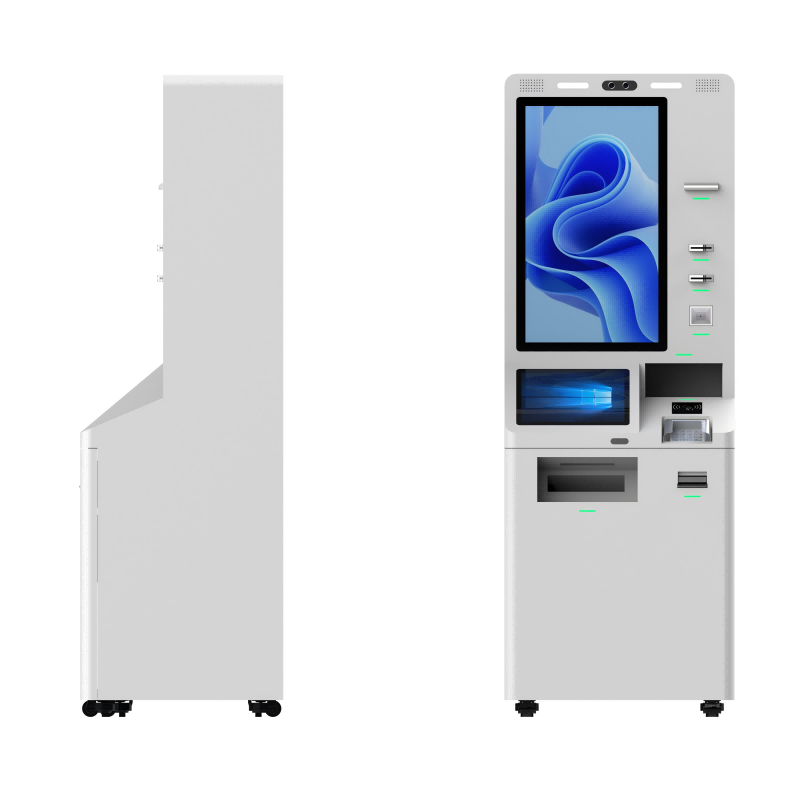
The cost of deploying an ATM kiosk involves several factors, including the purchase of the machine, installation, software integration, and ongoing maintenance. Typically, the initial investment can range from $2,000 to $20,000 per kiosk, depending on the complexity and features. Operational costs include electricity, internet connectivity, cash management, and regular servicing.
However, the return on investment (ROI) can be substantial. ATM kiosks generate revenue through transaction fees, which can quickly offset initial costs. Moreover, they reduce staffing needs and overhead by automating routine transactions, leading to significant long-term savings. Additionally, the increased customer convenience and extended service hours boost customer satisfaction and loyalty, further driving profitability. In high-traffic areas, the break-even point can be reached within a few years, making ATM kiosks a cost-effective solution for financial institutions looking to expand their service reach while maintaining cost efficiency.
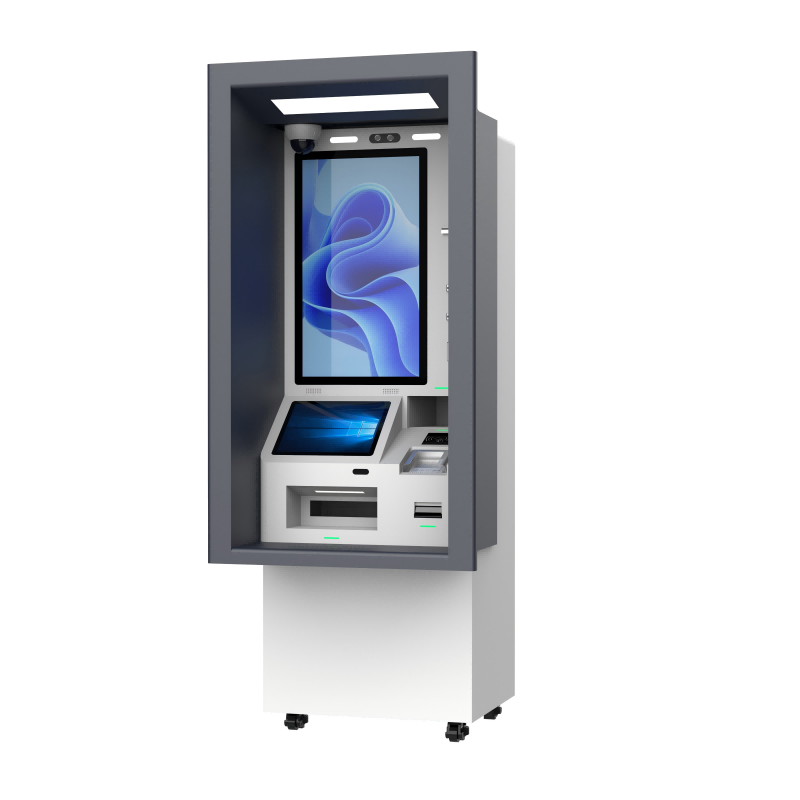
Location and Placement: Consider where the kiosk will be installed. High-traffic areas, both indoor and outdoor, require different features such as weatherproofing and security measures.
Security Features: Ensure the kiosk includes advanced security measures like surveillance cameras, encrypted transactions, anti-skimming devices, and secure cash storage to prevent theft and fraud.
Customization Options: Assess the need for customization in terms of branding, user interface, and specific functionalities. The kiosk should align with your company’s branding and operational requirements.
Compliance with Regulations: The kiosk must comply with local and international banking regulations, including ADA (Americans with Disabilities Act) compliance, to ensure accessibility for all users.
Technology and Software Integration: Verify that the ATM kiosk is equipped with the latest technology and can integrate seamlessly with your existing banking software systems, including updates and technical support.
Total Cost of Ownership: Consider not just the initial purchase price but also the long-term costs such as maintenance, software updates, and cash management services to ensure the investment is sustainable over time
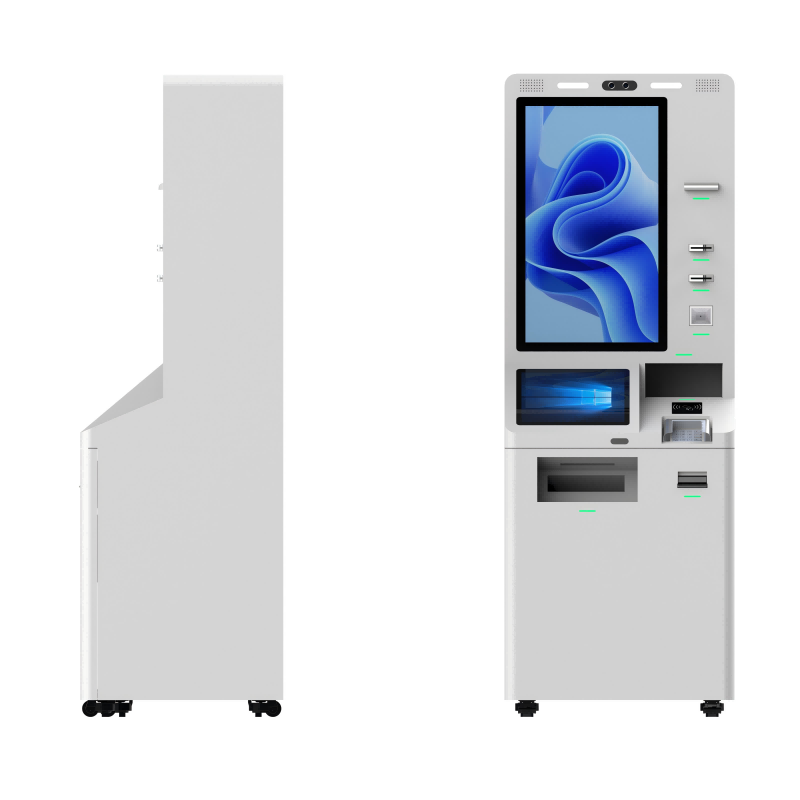
| Type | Size | Design Features | Price Range |
|---|---|---|---|
| Standard ATM | Compact to Medium | Basic functionality, touch screen | $2,000 - $5,000 |
| Outdoor ATM | Medium to Large | Weatherproof, enhanced security | $4,000 - $8,000 |
| Multi-Function ATM | Medium to Large | Cash withdrawal, deposits, bill payments | $6,000 - $12,000 |
| Interactive ATM | Medium to Large | Advanced features, multimedia | $8,000 - $15,000 |
| High-Traffic ATM | Large | High durability, large cash capacity | $10,000 - $20,000 |
Define Requirements: Determine the features you need, such as cash dispensing, deposit capabilities, or interactive functions. Consider the size and design that fit your location and usage volume.
Research Manufacturers: Look for reputable ATM manufacturers with a track record of reliability and customer support. Check reviews and case studies to gauge their product quality.
Compare Models: Evaluate different models based on functionality, size, design, and price. Ensure the models meet your requirements and offer the features you need.
Check Security Features: Ensure the ATM has robust security features, including encryption, fraud detection, and physical security measures to protect against theft and tampering.
Consider Maintenance and Support: Choose a manufacturer that offers comprehensive maintenance and support services. Ensure they provide regular software updates and responsive customer service.
Review Total Cost of Ownership: Calculate the total cost, including initial purchase, installation, maintenance, and transaction fees. Assess the long-term ROI to ensure it aligns with your budget and financial goals.
Request a Demonstration: If possible, request a demo of the ATM machine to test its functionality and ensure it meets your expectations before making a purchase
What did our happy clients say?
Absolutely thrilled with our new kiosk ATM! It’s reliable, user-friendly, and has significantly boosted our customer satisfaction. The installation was seamless, and the support team has been fantastic. Highly recommend the kisok manufacturer of Lean Kiosk System!
The kiosk ATM machine we purchased has exceeded our expectations. It’s robust, secure, and easy for customers to use. The custom features and excellent support have made a big difference in our operations. Great investment for our business!
We are very pleased with our new ATM machine. It integrates perfectly with our existing systems and has proven to be very durable. The quality of the product and the professional service provided were top-notch!
Our experience with this kiosk ATM has been fantastic. The machine works flawlessly, and the features are exactly what we needed. The customer service has been outstanding, making the entire process smooth and efficient. Highly satisfied!